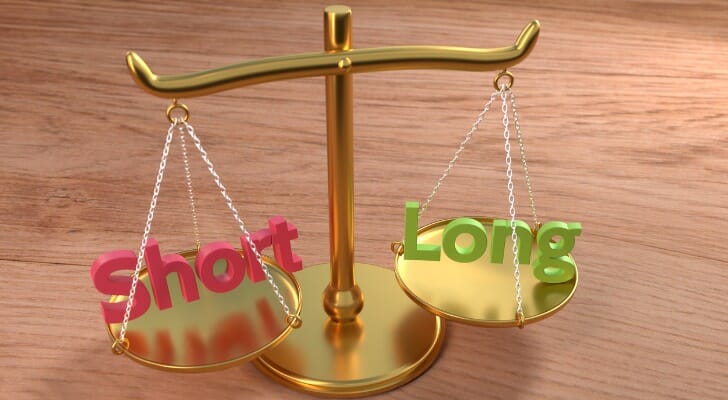 Trading options, which are a type of derivative security, may appeal to investors who are comfortable taking on more risk for the potential to earn higher returns. It’s helpful to understand certain options trading terminology before diving in, including the difference between American and European style options. The two share some similarities but they differ when it comes to when options can be exercised. If you’re interested in options trading, comparing American vs. European options can help with deciding which ones to trade. Deciding which types of options to trade is best done with the insights and guidance of a financial advisor.
Trading options, which are a type of derivative security, may appeal to investors who are comfortable taking on more risk for the potential to earn higher returns. It’s helpful to understand certain options trading terminology before diving in, including the difference between American and European style options. The two share some similarities but they differ when it comes to when options can be exercised. If you’re interested in options trading, comparing American vs. European options can help with deciding which ones to trade. Deciding which types of options to trade is best done with the insights and guidance of a financial advisor.
Options Trading Basics
An option is a contract that gives you the right, but not the obligation, to buy or sell a particular asset by a set date. Options are derivatives since their value is based on the value of the underlying asset.
A put option affords you the right to sell, while a call option gives you the right to buy. Both types of options are written with a strike price built in, which is a predetermined price at which an asset can be sold or bought. Call and put options also have expiration dates, which are deadlines by which the option must be exercised.
Exercising an option simply means exercising the right it conveys, i.e. either to buy or sell. If the option isn’t exercised by its expiration date, it expires worthless. This expiration date is included in the options contract at the time that it’s written. The window you have in which to exercise the option is determined by whether you’re trading American vs. European options.
Keep in mind, too, that any gains made in options trading are always short-term capital gains and are taxed accordingly. In other words, to walk away with gains that justify the risk and effort, those gains must exceed both the taxes on those gains plus all related fees entailed in the trade.
American Options, Explained
American style options can be exercised at any time prior to the option contract’s expiration date. Depending on the terms of the contract, this may be several days, several weeks or several months in the future. This means that if you’re trading American options you can decide to exercise the option at any time leading up to the expiration date.
So, here’s an example. Say you hold a call option to buy 100 shares of ABC stock at $100 per share. The stock is currently trading at $90 per share but you think its price will climb to $120 per share after the next earnings call. You have a 30-day window in which to exercise the option before it expires.
On Day 15 of that window, the stock’s price shoots up to $130 per share. If you don’t think the price will go any higher before the expiration date, you could decide to exercise your option to buy it at $100 per share. You could then turn around and sell those shares at a profit, less what you paid as a premium fee to purchase the option’s contract.
American options are more commonly associated with stocks or exchange-traded funds (ETFs). You’re less likely to find American-style options contracts associated with indexes.
European Options, Explained
 European options can only be exercised on their expiration date. This, along with the fact that European options are more closely linked with indexes, is what distinguishes them from American-style options. You can trade call or put European options and again, profiting from these trades can depend on where the strike price is relative to the underlying asset’s current market price at the time of expiration. This is where it’s important to understand whether an option is in the money, out of the money or at the money. These three terms are used to describe an option’s intrinsic value.
European options can only be exercised on their expiration date. This, along with the fact that European options are more closely linked with indexes, is what distinguishes them from American-style options. You can trade call or put European options and again, profiting from these trades can depend on where the strike price is relative to the underlying asset’s current market price at the time of expiration. This is where it’s important to understand whether an option is in the money, out of the money or at the money. These three terms are used to describe an option’s intrinsic value.
- In the money. An option is in the money if it has intrinsic value. A call option, American style or European style, is in the money if the strike price is below the asset’s market price. A put option is in the money if the strike price is above the asset’s market price.
- Out of the money. Out of the money options have no intrinsic value. A call option is out of the money if the strike price is above the asset’s market price. A put option is out of the money if the strike price is below the asset’s market price.
- At the money. An option, whether call or put, is at the money when the strike price and the asset’s market price are the same.
Both are important to understand whether you’re trading American vs. European options, but especially so with European options. Because your window for exercising options is fixed, you have to be fairly certain about which way an asset’s price will move. Otherwise, your options could expire worthless and you’d be out the premium you paid to purchase the contract.
American vs. European Options: Which Is Better?
Whether you trade American or European options can largely depend on the underlying assets you’re interested in. If you’re primarily a stock or ETF trader, then you may be dealing with American options most of the time. On the other hand, if you prefer an index investing strategy then you may be investing in European-style options.
So is one better than the other? Yes and no. American options offer the benefit of flexibility since you can exercise options contracts at any time before they expire. But there may be a cost trade-off, as American options may come with a higher premium for that convenience.
Keep in mind that there are also no guarantees that you’ll be able to reap bigger profits with American vs. European options since it largely depends on being right about the direction an asset’s price is moving. So going back to the previous example, say you exercise your option on Day 15 and buy the stock at $100 per share. You’ve still made a profit since you resold those shares at their current market price of $130. But what if the day before the option is set to expire, the price increases to $150 per share?
You’ve missed out on additional profits by exercising the option early. Of course, the opposite could happen and the stock’s price could tank to $80 per share, which would have made the option worthless to you. But this is a good example of how options can carry higher risk since they’re more speculative in nature than equities.
How to Get Started With Options Trading

If you’re interested in trading American or European options, opening a brokerage account is the first step. When comparing brokerages, look for ones that specifically offer options trading as not all of them do. And check the fees you’ll pay to trade options on the platform.
From there, you can evaluate what type of options contracts you want to trade. This is where different options trading strategies come into play. For example, you might use a strategy like a covered call to hedge your bets. With a covered call, you write a call option for a particular security while also holding the underlying asset in your portfolio.
The purpose in doing so is to minimize downside risk. If you sell the option you collect a premium from the investor who buys it. If the investor exercises the option then you have to sell them the shares you hold but you get to keep the premium. If the investor doesn’t exercise the option, you get to keep the premium and the shares.
This is just one way to utilize options trading strategies. When weighing options in your portfolio, consider your risk profile as well as your typical holding period for securities. This can help you decide how much of your investment dollars to allocate to options trading.
The Bottom Line
When discussing American vs. European options the most important thing to know is how they deal with expiration dates and when options can be exercised. You can use that as a framework for developing an options trading approach that fits the objectives of your investment portfolio and risk tolerance.
Tips for Investing
- If you’re trading options on margin, it’s important to understand the potential implications of doing so. Trading on margin means you’re using money borrowed from your brokerage to trade. Margin trading could significantly amplify your investment returns but it can also enhance risk and losses in turn. If your hunch about a security’s price doesn’t pan out you may be subject to a margin call. In this instance, you’ll be required to add money to your brokerage account to be able to continue trading to make up a margin deficit.
- Consider talking to your financial advisor about the pros and cons of options trading and how American vs. European options work. If you don’t have a financial advisor yet, finding one doesn’t have to be complicated. SmartAsset’s financial advisor matching tool makes it easy to connect with professional advisors in your local area. You’ll just need to answer a few simple questions to get your personalized recommendations. If you’re ready, get started now.
Photo credit: ©iStock.com/PashaIgnatov, ©iStock.com/chaofann, ©iStock.com/AJ_Watt